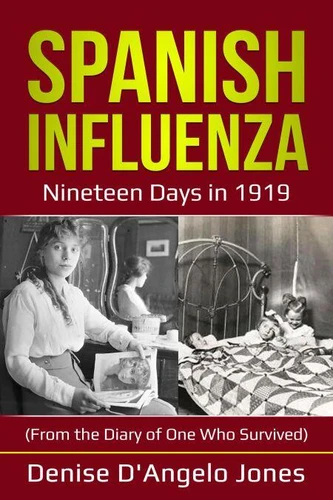Spanish Influenza: Nineteen Days in 1919
Par :Formats :
Disponible dans votre compte client Decitre ou Furet du Nord dès validation de votre commande. Le format ePub est :
- Compatible avec une lecture sur My Vivlio (smartphone, tablette, ordinateur)
- Compatible avec une lecture sur liseuses Vivlio
- Pour les liseuses autres que Vivlio, vous devez utiliser le logiciel Adobe Digital Edition. Non compatible avec la lecture sur les liseuses Kindle, Remarkable et Sony
 , qui est-ce ?
, qui est-ce ?Notre partenaire de plateforme de lecture numérique où vous retrouverez l'ensemble de vos ebooks gratuitement
Pour en savoir plus sur nos ebooks, consultez notre aide en ligne ici
- FormatePub
- ISBN978-1-393-75849-5
- EAN9781393758495
- Date de parution08/07/2020
- Protection num.pas de protection
- Infos supplémentairesepub
- ÉditeurRelay Publishing
Résumé
In the winter of 1919, the entire town of Mendota, Illinois was stricken by the third wave of the Spanish Flu. German baker Henry Zapf, forty-nine, was working sixteen-hour shifts a day to support his family. Hilda, his daughter, was nineteen at the time, and as the eldest daughter she was given the immense responsibility of holding down the fort at home. At the time, Hilda had eight siblings, seven of whom (along with her mother), were all in bed, coughing, sneezing, filling bedpans, wearing nightgowns drenched with sweat, delirious with high fevers, and unable to walk without assistance. The amount of work needed to be done each day to provide quality care must have been overwhelming.
Hilda was forced to switch from her role as her mother's cooking and cleaning assistant to becoming a 24/7 caregiver. With the help of a hired nurse, Miss Schueller, and Hilda's beloved live-in Aunt Lizzie (Elizabeth Langlitz Kratsch), the entire family survived the deadliest pandemic of the twentieth century. Hilda documented how her family and community survived the virulent flu in her descriptive diary entries.
Hand washing, lockdowns, mask wearing, and daily visits from Dr. E. P. Cook, Jr. (who had lost his wife a year earlier) were all recorded by Hilda in her diary, along with town gossip-- and a few giggles-- which are shared in this book.
Hilda was forced to switch from her role as her mother's cooking and cleaning assistant to becoming a 24/7 caregiver. With the help of a hired nurse, Miss Schueller, and Hilda's beloved live-in Aunt Lizzie (Elizabeth Langlitz Kratsch), the entire family survived the deadliest pandemic of the twentieth century. Hilda documented how her family and community survived the virulent flu in her descriptive diary entries.
Hand washing, lockdowns, mask wearing, and daily visits from Dr. E. P. Cook, Jr. (who had lost his wife a year earlier) were all recorded by Hilda in her diary, along with town gossip-- and a few giggles-- which are shared in this book.
In the winter of 1919, the entire town of Mendota, Illinois was stricken by the third wave of the Spanish Flu. German baker Henry Zapf, forty-nine, was working sixteen-hour shifts a day to support his family. Hilda, his daughter, was nineteen at the time, and as the eldest daughter she was given the immense responsibility of holding down the fort at home. At the time, Hilda had eight siblings, seven of whom (along with her mother), were all in bed, coughing, sneezing, filling bedpans, wearing nightgowns drenched with sweat, delirious with high fevers, and unable to walk without assistance. The amount of work needed to be done each day to provide quality care must have been overwhelming.
Hilda was forced to switch from her role as her mother's cooking and cleaning assistant to becoming a 24/7 caregiver. With the help of a hired nurse, Miss Schueller, and Hilda's beloved live-in Aunt Lizzie (Elizabeth Langlitz Kratsch), the entire family survived the deadliest pandemic of the twentieth century. Hilda documented how her family and community survived the virulent flu in her descriptive diary entries.
Hand washing, lockdowns, mask wearing, and daily visits from Dr. E. P. Cook, Jr. (who had lost his wife a year earlier) were all recorded by Hilda in her diary, along with town gossip-- and a few giggles-- which are shared in this book.
Hilda was forced to switch from her role as her mother's cooking and cleaning assistant to becoming a 24/7 caregiver. With the help of a hired nurse, Miss Schueller, and Hilda's beloved live-in Aunt Lizzie (Elizabeth Langlitz Kratsch), the entire family survived the deadliest pandemic of the twentieth century. Hilda documented how her family and community survived the virulent flu in her descriptive diary entries.
Hand washing, lockdowns, mask wearing, and daily visits from Dr. E. P. Cook, Jr. (who had lost his wife a year earlier) were all recorded by Hilda in her diary, along with town gossip-- and a few giggles-- which are shared in this book.



